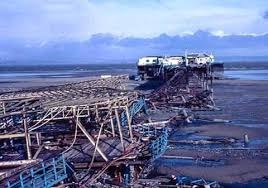
The clue is in the name: Poulton – a settlement by a pond or pool. With no sea defences as such, Poulton and its neighbours had to make the most of the landscape, setting themselves on hills or behind higher ground, seeking shelter from storm and flood.
Caught between the sea and storms on one side and the flood plain of the Lune estuary on the other, there must have been many past inundations which have gone unrecorded.
From the 1850s onwards as Morecambe began to be established, there are regular reports of damage to new sea walls, wind damage and flooding (some as far inland as what is now the Shrimp Roundabout.
Many people still remember the storm of 1977 with gales of up to 92 mph and widespread flooding as the central promenade was breached. The most notable casualty was the West End Pier. This had suffered various mishaps over the years but finally fell victim to the storm, apparently because it had been fixed too rigidly to the promenade – with a bit more flexibility it might have survived. The morning after, the beach was alive with scavengers, many searching for pennies lost overboard from the slot machines.
Another notable storm took place on Mothering Sunday in 1907. A spring tide, south westerly gale and the Lune in flood after a month’s rainfall all combined to cause a breach in the West End promenade and widespread flooding inland. Around the Stone Jetty stone blocks were thrown about by the waves and the workshops of Wards Shipbreakers were damaged. The Ben-my-Chree, a paddle steamer with the Isle of Man Steam Packet Company awaiting scrapping, broke its moorings and had to be scuppered to stop it being carried away.
Inland there was flooding around Charles Street and Out Moss Lane resulting in the loss of livestock, as well as floods on White Lund, around Woodhill, Overton and Snatchems. Food and supplies had to be brought to stranded householders by boat.
Along Sandylands, front gardens were wrecked, and cellars and lower floors flooded. Furniture was to be seen floating down streets (a similar sight was reported in Parliament Street in 1977).
Sandylands Promenade was again wrecked by a storm at the very end of 1925. Its repair and, more importantly, its repair bill, led to the amalgamation of Morecambe and Heysham in 1928.